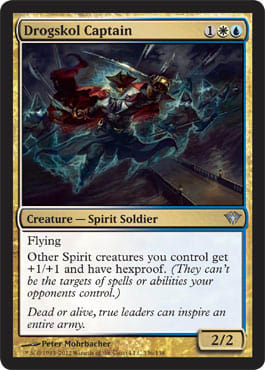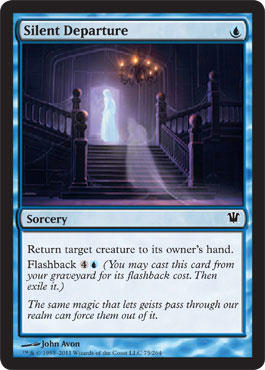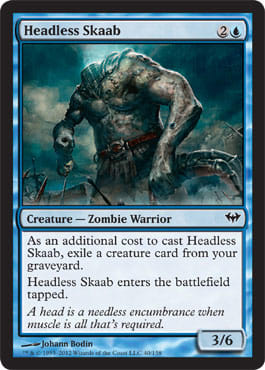Everyone knows that reading, writing and arithmetic are the key subjects in grade school. They are also the keys to Magic Booster Draft. Pack one is when school is in session. While the first several picks in pack one often involve extremely important and difficult decisions, the choices made in pack one often make it so a bot could draft packs two and three reasonably well for you with minimal programming.
Reading
There are three ways to read when drafting:
- Read the format – I often like to study the format in order to determine what colors have the most powerful cards and the most powerful synergies. Even when this isn’t obvious, I can usually at least determine which of the most powerful archetypes is best suited to my play style and preferences. If you are able to determine an archetype that gives you the best chance of winning when you can find it (especially if it’s a deep one), you can start drafting it from pack one, pick one and end up with a good deck without reading what’s coming to you. One of the things about this approach is that a well-programmed bot could probably draft all three packs for you and give you a decent deck. This is probably among the reasons Rada Rudyak dislikes this approach so much—she has a quite low boredom threshold. The first pack is so important when reading the format because of the story you’re writing, not because of the information you’re reading.
- Read the cards – Many people subscribe to the take-the-best-card-in-the-pack philosophy when making their first few picks. This helps increase their chances of having bombs in their deck and helps avoid accidentally putting the player behind them into a color they might later end up wanting to be in. When using this approach, I will typically try to lock into colors pretty quickly in order to aid the story I’m writing for the player behind me. After five or six picks, I can usually identify which colors among the cards I’ve picked have the most potential to be the building blocks for a good deck. Then, I can ignore the cards I might have drafted in other colors and proceed with a more focused plan.
- Read the seat – This is the purest reading approach. The idea behind this approach is to try to determine what two colors or what archetype is the most available in your Draft position. Initially, you start by reading the cards. You don’t need to lock into colors as quickly, though. For example, I like to pay very close attention to the cards in my opening pack so that when it comes back to me for my ninth pick, I often have pretty telling information about the drafters sitting right in front of me. If the fourth- or fifth-best card is still there, for example, I can be pretty sure the person in front of me isn’t in that color. It’s not just about what colors are coming, either. In Innistrad block Draft, for example, perhaps I don’t see many Zombies coming, but if see some black cards that are good for the W/B Human archetype coming really late, it still might be right to go black.
Writing
Obviously, the more time you spend reading, the less time you have for writing. While I believe how you choose to read the Draft is more important than how you write it, I also think the story you’re telling is often a bit overlooked. There is almost always a direct correlation to the choices you make in pack one to how well the Draft goes for you in the next two packs—although especially in pack two, of course.
Many people focus almost entirely on reading what’s coming to them because the person on the right will be passing them two thirds of their cards. Realistically, though, it’s closer to fifty-fifty than most people realize when it comes to your meaningful picks. In pack one, the person on your right usually takes a while to figure his or her colors out, sometimes not even figuring out a plan until reviewing picks between packs one and two. If you do a good job communicating your message to the player on your left during pack one, you’ll often receive considerably higher-quality picks in pack two than you would pick up in pack one or pack three. It’s somewhat obvious that pack one can be a bit of a crapshoot, but this is the very reason that pack three might be one, too: Your opponent may have given you poor signals in pack one, or perhaps pack one was just really loaded in a couple colors and pack three wasn’t.
The point is that it’s often easier for you to create a strong symbiotic Draft relationship with the player on your left than the player on your right. At the very least, you have much more control over the signals you’re sending than on the ones being sent to you. I suspect this is among the reasons I choose the read-the-format option so frequently: I’m a bit of a control freak, and I like to be less dependent on the person in front of me.
“Reading the format” is even somewhat of a misleading name—it’s so much more about sending signals than receiving them. This week, I forced W/U in a Draft at my local game store, and it turned out that the player to my right opened a Drogskol Captain. Unfortunately for me, he took the Captain and then drafted a W/U Spirits deck directly in front of me. Even so, I ended up with a fantastic deck. This was in large part because the guy to my left was receiving extremely clear signals, and pack two was fantastic for me, with great cards for me to choose almost every pick.
Arithmetic
The keys to determining your colors in Draft are reading and writing, but you still need to decide between cards of those colors each pick. This is where the math comes in. You are constantly faced with choices between two creatures, two spells, a creature and a spell, or sometimes more than two different cards. You could keep it simple by just taking the “best” card with each pick, but that doesn’t actually mean you’ll have a good deck. This is the key concept, of course: You need to build a deck, not merely a collection of good cards.
This concept was extremely relevant in my Draft this week when I played the W/U player who sat to my right during the Draft. If you assigned a number value to every card in our decks based on their power levels, his deck would receive a higher score, yet I won 2–0. One of the reasons was that while he drafted a more powerful collection of cards, I drafted a more cohesive deck. I had a better mana curve with tighter synergies. Generally, I would put threats into play before he did and put him on the defensive. When he would try to relieve the pressure by enchanting my creatures, I would bounce them with Silent Departures and replay them. When he eventually generated enough mana to start playing bigger and better creatures than mine, I was able to tap them, bounce them, or enchant them with my own spells while finishing him off.
There are a lot of calculations that you should be making when drafting. These calculations become much easier as the Draft does on. For example, if you don’t have any 2-drops at the beginning of pack three, it’s obvious you need to make acquiring them a priority for that pack. Knowing what to prioritize in the first pack is much more difficult.
The first thing you need is an understanding of mana curve in Draft. Rada went 3–0 in my Draft with an amazing R/G Werewolf deck with a great curve:
1 – Reckless Waif, Forge Devil, Faithless Looting
2 – Ashmouth Hound, Ambush Viper, Mulch, two Village Ironsmith
3 – Splinterfright, Immerwolf, Hanweir Watchkeep, Kruin Outlaw, Elder of Laurels
4 – Mondronen Shaman, Kessig Recluse, Russet Wolves, Wrack with Madness
5 – Kessig Cagebreakers, Grizzled Outcasts
6 – Markov Warlord
She also had three spells in her deck she could use as needed: Blasphemous Act, Wild Hunger, and Moonmist. If I was making an ideal curve, I would probably make one of the 3- or 4-drops into a 2-drop or a 1-drop, but I certainly wouldn’t complain if I ended up with this deck in Draft.
One of the biggest things that you should take notice of is that she’s only making use of two 5-drops and one 6-drop. This is a pretty optimal number, and if she had more flashback cards such as Wild Hunger and Faithless Looting, she could probably have an excellent deck with zero 6-drops and maybe even one or zero 5-drops. My deck only had one 5-drop—Battleground Geist—and no 6-drops, but I had plenty of things to do with my mana in the late game: Feeling of Dread, Stitcher's Apprentice, Divination, Think Twice, two Avacynian Priest, and two Silent Departure. You’ll also notice that at the top of both my and Rada’s curve is a card that can help beat your opponent the same turn that you play it. I try hard to avoid having to invest a lot of mana into cards that won’t help me immediately.
The big point here is that while 5- and 6-drops are quite valuable in Sealed, their value drops significantly in Draft. While a 6-drop in your opening pack can be shiny and exciting, if you take it, it will usually be the correct play to pass every other 6-drop you see for the rest of the Draft. So, in pack one, an A− 2-drop is way more exciting than an A− 6-drop because you need a lot of 2-drops. If your choice is between an A+ 6-drop and and a B− 2-drop, I’d probably take the 6-drop knowing I wasn’t going to have regrets when I had to pass on future 6-drops.
Since the guy on my right was drafting my colors from pick one and the rest of the table was picking a few good cards in my colors while figuring out what colors they were in, I didn’t end up using many overly powerful Dark Ascension cards in my deck: Break of Day, Niblis of the Urn, Screeching Skaab, Headless Skaab, Skillful Lunge, Divination, and Thought Scour. Even with just these seven cards, I laid important groundwork for the large quantity of good W/U cards I picked in Innistrad.
I picked up a pair of 2-drops and a potential 3-drop. I grabbed four spells, which ended up being helpful in part because I ended up running a Delver. The Thought Scour and Screeching Skaab made drafting flashback cards and Zombies better. Also, cards such as Niblis of the Urn, Skillful Lunge, and Break of Day are best in creature-heavy, aggressive decks, which I kept in mind while drafting packs two and three.
By taking into account your potential future needs and your overall needs when making your choices in pack one, you will save yourself from finding yourself in situations in pack three where you have to take a B− 2-drop over an A+ 5-drop. It will also help make sure you end up with a synergistic deck and not just a collection of good cards that happen to be in the same two colors.
Being a top drafter requires mastering multiple elements. If you can get a handle on reading Draft information, sending information, and doing the math for your deck on the fly, you will find that you will always have a deck that will give you a chance to win. School’s out!
























